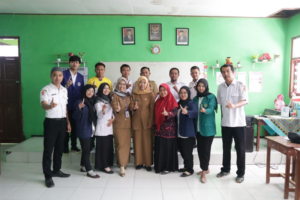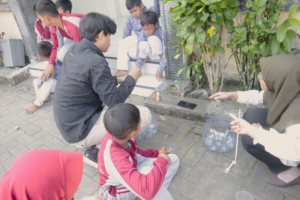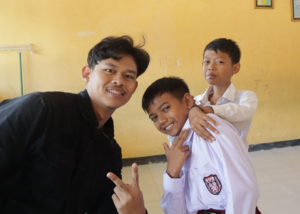Departemen Sastra Inggris Adiliawan M Al Hakim
Dr. Lestari Setyowati , M.Pd
Nanang Zubaidi , S.S., M.A., Ph.D.
1 April 2023
Learning and students SDG 4, SDG 15
From February 20 to June 16, 2023, I had the privilege of participating in Kampus Mengajar 5, an initiative spearheaded by the Minister of Education and Culture, Nadiem Makarim. I first learned about the program during my fourth semester when many of my friends were already involved. Initially, I hesitated to join due to concerns about potential study delays. However, upon discovering that I could convert the courses I was supposed to take during that semester, my interest was piqued. Additionally, the program offered the flexibility to choose the school where I would be placed, which led me to select my hometown of Bojonegoro. After careful consideration with my friends and parents, I decided to participate in the MBKM Kampus Mengajar 5 program during my sixth semester. Fortunately, after a rigorous selection process, I was accepted and had the opportunity to return to my hometown.
Throughout the program, our activities primarily took place at SDN Sambongrejo 1, a remote primary school located in the Gondang sub-district of Bojonegoro. Despite the considerable distance from my home, the breathtaking view I witnessed made the journey worthwhile. A week before the official start of the Kampus Mengajar 5 program at SDN Sambongrejo 1, my team, consisting of Nila Ika Nurwahyuni, Adiliawan M Hakim, Ellycia Rahma, Nurfidya Fahreza, and Siska Dewi Irmawati, conducted a thorough survey of the school’s location. This served to familiarize ourselves with the terrain and understand the school’s specific context. After a roughly one-hour ride, we reached Sukun village, where we engaged with local residents to gather information about SDN Sambongrejo 1. To our surprise, we discovered that the school was located in two different places, Sukun and Kaliasin. With our survey completed, we officially launched the Kampus Mengajar 5 program at SDN Sambongrejo
1 on February 21, 2023, and then we started the program’s opening event attended by our dedicated field supervisor, Anis Umi Khoirotunnisa’ M.pd, our coordinating teacher, Diah Putri Novitasari S.pd, and other school staff. Their warm welcome and support uplifted our spirits as we embarked on our mission. During that week, we conducted an observation aimed at identifying areas for improvement and gaining valuable insights into the school’s infrastructure, resources, and educational practices. This enabled us to develop tailored strategies to address any shortcomings and enhance the overall learning environment. Our primary focus throughout the program was to enhance the students’ literacy and numeracy skills. To achieve this, we implemented various activities, including literacy programs, reading sessions, English language lessons, crafting, and the integration of technology into the learning process. Our programs align with SDG 4, which aims to ensure inclusive and equitable education for all. Moreover, our efforts in improving the learning environment and promoting sustainable practices within the school community directly support SDG 15, which focuses on protecting and restoring ecosystems and promoting sustainable land use. By addressing these crucial aspects, our program not only fostered educational development but also contributed to the overall well-being and resilience of the community.
Picture 1: Documentation after the program’s opening event
On the first day of our placement, we were warmly welcomed at SDN Sambongrejo 1. Mrs. Nur, the school principal, provided us with a brief overview of the school’s condition, and we introduced the MBKM program ourselves. Shortly afterward, we conducted a comprehensive tour of the school to assess the surrounding conditions and relevant facilities. After completing our observations, we requested specific data to support the program we were going to develop and offer solutions to the challenges faced. Towards the end of the school day, my team and the gathered in the teachers’ room for a launch. On the second day, we conducted a more detailed observation of the students’ conditions and individual abilities, including those who were still struggling with reading or arithmetic skills. Additionally, we visited the library to assess its resources, gather data for future inventory, and determine the necessary steps to be taken. We also conducted observations in the school’s surrounding environment.
Picture 2: After English literacy learning using LKPD
We asked the students to attach their worksheets to the information board that we had set up. Following that, we conducted a worksheet-based activity in the form of a crossword puzzle to fill in the names of fruits in English. During the activity, the students were given a crossword puzzle to complete by filling in the empty boxes with the appropriate names of fruits in English. Before starting to work on the crossword puzzle, the students were instructed to read the clues and fill in the empty boxes with the corresponding fruit names. Subsequently, we provided ample time for the students to work on the crossword puzzle. If any students encountered difficulties, we offered additional guidance to assist them in finding the answers. After the students completed the crossword puzzle, we reviewed their answers and praised or rewarded those who had successfully completed it correctly and within the given timeframe. Consequently, this activity aimed to help students improve their English language skills and facilitate a more enjoyable and practical learning experience.
Picture 3: recycling program by creating flower pots from used water-gallon containers
We organized a recycling program by creating flower pots from used water-gallon containers. This activity aimed to fulfill the Sustainable Development Goals (SDG) target number 15, which focuses on protecting, restoring, and promoting sustainable use of terrestrial ecosystems, sustainably managing forests, combating desertification, and halting land degradation, and biodiversity loss. We chose this program to meet these objectives because, by recycling used water-gallon containers, we can reduce plastic waste that harms the environment. Additionally, we can contribute to the preservation of biodiversity by planting local endemic plants in these pots, such as fruit-bearing plants like guava, starfruit, and sapodilla, or flowering plants like bougainvillea.
The activity ran smoothly as the fifth-grade students showed great enthusiasm for making these plant pots. To make the pots, we divided the fifth grade into three groups, with each group creating one flower pot. Their task was to paint the pots that we had assembled. We handled the assembly process ourselves as it required adult supervision due to the use of sharp tools for cutting and drilling the pots. We also used a strong adhesive that could be difficult to remove when it came into contact with the skin. Thus, we were concerned that the children might get injured if they assembled the pots themselves. Instead, they could showcase their creativity by painting the pots. After finishing the pots, they decorated them, and we placed them in a well-ventilated area to allow the paint to dry. We avoided direct sunlight to prevent any damage to the paint. The final artwork was temporarily stored in the teacher’s room to ensure its safety from other students.
Picture 4: Me taking a picture with 5th-grade students of SDN Sambongrejo 1.
One of the most important lessons I learned from that experience is the appreciation for simplicity and the happiness that can be found in simple things. Through my interactions with students in rural environments, I witnessed their genuine joy in pursuing education despite the limited resources. They taught me the importance of being grateful for what we have and living life with enthusiasm and determination. The experience of living a simple life also taught me valuable values such as hard work, perseverance, and creativity in the face of challenges. I saw firsthand how the students were able to overcome their limitations with limited resources through collaborative efforts and innovative solutions. This experience served as a reminder for me to appreciate and make the most of the resources available to me wisely and thoughtfully.





